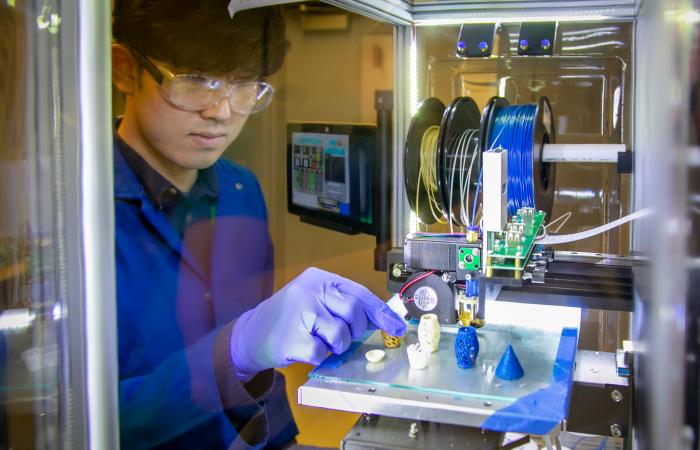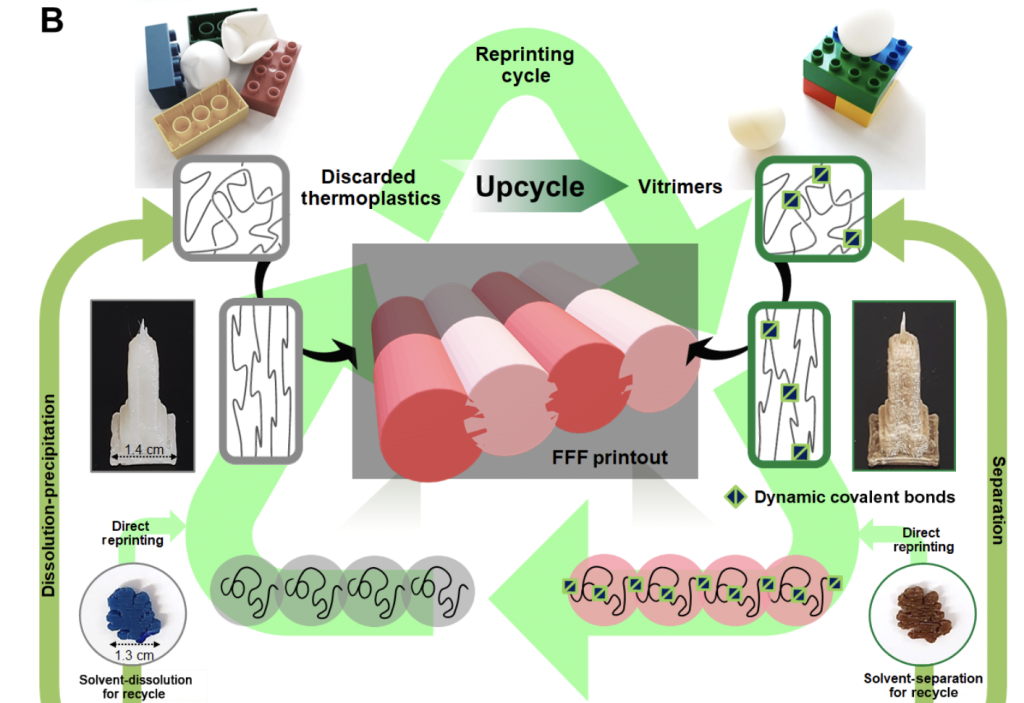Researchers at Oak Ridge National Laboratory (ORNL) have come up with a novel way of turning discarded plastic into a Fused Filament Fabrication (FFF) 3D printing material.
Using a ‘click chemistry’ reaction, the scientists’ method enables waste ABS to be turned into a ‘vitrimer,’ a polymer with the recyclability of thermoplastics and mechanical qualities of thermosets. According to the team, this “readily adoptable” process could serve as a basis for the introduction of “a closed-loop strategy,” that reduces the need for new plastics and cuts emissions tied to their production.
“We will need fundamental discoveries to overcome the challenges of increased costs and deteriorating material properties associated with recycling,” said lead author Tomonori Saito of ORNL’s Chemical Sciences Division. “Our goal was to develop an easily adoptable strategy that reuses plastic waste to create a more valuable material instead of generating fresh plastic.”

Tackling single-use plastic production
In the researchers’ paper, they highlight how the production and incineration of plastics is set to be responsible for 16% of all global net carbon emissions by 2050. With this in mind, they say the development of circular alternatives to single-use polymers is set to be crucial to the realization of net-zero manufacturing, and tackling global climate challenges.
However, developing such materials for FFF 3D printing has proven difficult thus far, as they need to be extrudable and printable, something that often renders cross-linked thermosets incompatible. As a result, despite users of the technology making up most of the market, they continue to miss out the mechanochemical properties of thermosets, such as epoxy, and have to settle for non-recyclable filaments.
That being said, ABS’ high flowability and ability to rapidly harden into rigid structures has seen it adopted by FFF 3D printing users and manufacturers alike. Given the popularity of the material and extrusion technology, the ORNL scientists have therefore identified them as an ideal basis for a sustainable closed-loop process, capable of serving as an alternative to single-use polymer production.
“ABS is one of the most widely used FFF-printable polymers with wide-ranging applications,” explain the team in their paper. “If discarded, commodity thermoplastics like ABS can be upcycled into materials with enhanced mechanical-chemical properties and (re)printability in desired 3D structures, such a strategy can epitomize transformative manufacturing toward better sustainability.”

ORNL’s ‘click chemistry’ approach
In order to transform ABS into a recyclable, FFF 3D printable vitrimer, the researchers focused on its rubbery butadiene segments, which contain the unsaturated double bonds needed to make it reusable. By adding a combination of dialdehyde and cysteamine, a compound traditionally incorporated into eye and skin medications, to these chemicals, the team found it possible to functionalize and convert them.
With the aim of testing the efficacy of this ‘click chemistry’ reaction, the scientists decided to 3D print parts from six different upcycled ABS formulations, before putting them through strength testing. Initial results showed that one material, ‘ALD-66,’ had an ultimate tensile of 44 MPa, making it over 80% stronger than neat ABS. However, the team ultimately chose to proceed with ‘ALD-33’ instead, due to its toughness and ductility, properties that are “desirable for fracture-free printing.”
When it came to quantifying their material’s recyclability, the ORNL engineers then deployed it to produce four samples, before repressing and reusing them for three successive print cycles. Interestingly, once they’d been through this, the ALD-33 samples were able to recover their molecular bonds in a way that saw them retain their elasticity, strength and ductility, without the need for any additives.
What’s more, when dissolved, the material could be mixed with normal PLA in a controlled way, to form blends with predetermined properties. By doing so, the scientists found they were able to develop a formulation that, when 3D printed into honeycomb structures, yielded parts with “excellent compressive properties,” akin to those of a beetle’s forewings.
With further development, the researchers say their approach could be used to improve the recyclability and strength of other printable thermoplastics, in a way that provides them with medical, automotive, robotics or electronics applications.
“The approach is extremely versatile,” added Sungjin Kim, a postdoctoral researcher at ORNL and contributor to the project. “Recovered upcycled ABS can be reused again and again for FFF with minimal loss of properties. It can also be combined with mixed and standard ABS, and directly printed as a blend.”
“This effort demonstrates a closed-loop for manufacturing plastic items, potentially with higher value and performance, using only existing plastic waste.”

Formulating sustainable filaments
As is the case in the wider manufacturing world, desktop 3D printer users are increasingly turning towards more sustainable filaments, and the portfolios of material developers are starting to reflect this growing demand. Braskem released its first sustainable 3D printing filament line last month at Rapid+TCT 2022, composed of a bio-based EVA, recycled polyethylene (PE) and polypropylene (PP).
Similarly, at this year’s South by Southwest Innovation Awards, UBQ Materials was recognized in the Speculative Design category for its waste-based 3D printing material. The ‘climate positive’ thermoplastic is designed to enable the additive manufacturing of complex parts with a reduced carbon footprint.
Elsewhere, on a more experimental level, researchers at the Massachusetts Institute of Technology (MIT) have come up with a novel plant-derived composite. Created using a mixture of synthetic plastic and cellulose nanocrystals (CNCs), the 3D printable material is said to feature a structure akin to that of a mollusk’s shell.
The researchers’ findings are detailed in their paper titled “Closed-loop additive manufacturing of upcycled commodity plastic through dynamic cross-linking.” The study was co-authored by Sungjin Kim, Anisur Rahman, Arifuzzaman, Dustin B. Gilmer, Bingrui Li, Jackson K. Wilt, Edgar Lara-Curzio and Tomonori Saito.
To stay up to date with the latest 3D printing news, don’t forget to subscribe to the 3D Printing Industry newsletter or follow us on Twitter or liking our page on Facebook.
For a deeper dive into additive manufacturing, you can now subscribe to our Youtube channel, featuring discussion, debriefs, and shots of 3D printing in-action.
Are you looking for a job in the additive manufacturing industry? Visit 3D Printing Jobs for a selection of roles in the industry.
Featured image shows ORNL’s Sungjin Kim 3D printing using a ‘vitrimer.’ Photo via Genevieve Martin/ORNL, U.S. Dept. of Energy.


